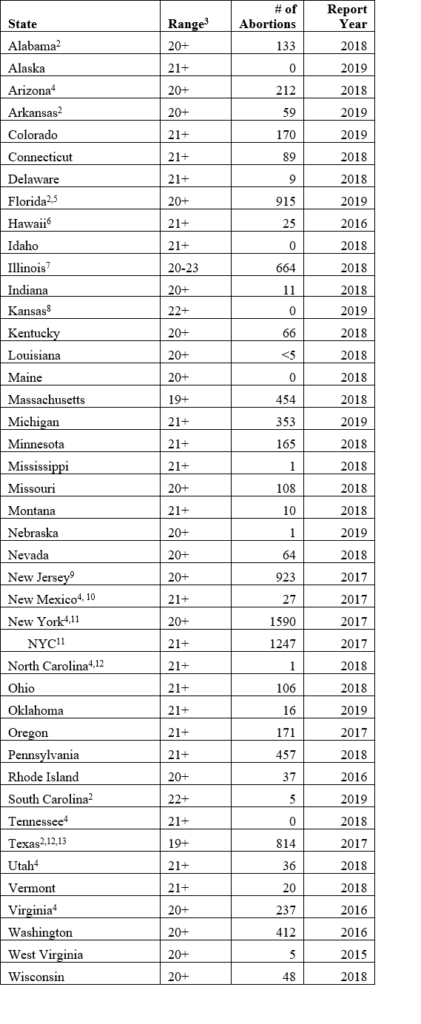Fact Sheet: Late-Term Abortion Stats
Originally published on September 9, 2019, and has been updated on June 30, 2020.
This entire report may be viewed as a PDF: Fact Sheet: Late-Term Abortions in the States
In the United States, abortion reporting at the national level is incomplete and out of date[i] with the most recent national abortion surveillance report covering data from 2016, as published by the U.S. Centers for Disease Control and Prevention (CDC). In order to get a more accurate and up-to-date count of late-term abortions,[ii] the Charlotte Lozier Institute (CLI) reviewed the most recent publicly available state abortion reports or reports provided to CLI, upon request, by the various state health and vital statistics departments.
In all, 48 reporting areas (46 states, New York City, and the District of Columbia) make abortion data publicly available. Of these, 46 report the gestational ages at which abortions are performed, and 43 report gestational age with enough granularity to allow for a count of late-term abortions. CLI has compiled a table below showing the number of abortions reported as performed close to or after 20 weeks of gestation in these 43 reporting areas.
Because abortion reports are produced independently by each reporting area, the ranges of gestational ages reported are not easily comparable from area to area, and information is not available from every reporting area for every year. Additionally, some reporting areas measure pregnancy using probable post-fertilization age (PPF age), while other reporting areas measure pregnancy using weeks of gestation, which is approximately two weeks greater than PPF age. For these reasons, the table below does not include a total; however, to enable easier comparisons, CLI has converted all to estimated gestational age (noting whether reporting areas originally used PPF age), the age ranges used by the reporting areas, and the most recent reporting year for each reporting area.
Late-Term Abortions in States that Report by Gestational Age (43)1
- Does not include 8 states and the District of Columbia: 4 states do not publish abortion statistics or did not provide abortion data to CLI when requested (CA, MD, NH, WY), 2 reporting areas do not report abortions by gestational age (DC, GA), 3 states do not report gestational age with sufficient specificity (IA, ND, SD).
- Gestational age measures pregnancy from the last menstrual period, while probable post-fertilization (PPF) age measures pregnancy from the probable date of conception. PPF age is approximately two weeks less than gestational age. AL, AR, FL, SC, and TX report using PFF age; these states’ reported abortions by PPF age have been converted to approximate gestational age.
- The majority of states report gestational age in ranges rather than by individual week.
- Reports only abortions performed on state residents.
- Florida’s abortion reports refer to “gestational age,” but the state defines gestational age to be equivalent to post-fertilization age.
- Hawaii’s most recent full abortion report is for 2009; consequently, CLI has used Hawaii data from the most recent CDC report (2016).
- Illinois suppresses the number of abortions performed on women of unknown residency between 20 and 23 weeks of gestation, as well as all abortions performed after 23 weeks of gestation, to protect confidentiality.
- In 2018, there were 234 Kansas abortions between 17-21 weeks of gestation that could have been performed in Kansas or on Kansas residents in other states. There were 5 abortions at 22 weeks or later that were all performed on Kansas residents in other states; these have not been included in Kansas’ late-term abortion total for 2018.
- Not all New Jersey abortion facilities are required to report abortions, so this number is incomplete.
- New Mexico reports the percentage of abortions performed at 21 weeks or later; CLI used the reported percentages to estimate the actual numbers.
- There is overlap between the New York State abortion report and the New York City abortion report.
- North Carolina and Texas report both in-state and out-of-state late-term abortions performed on state residents. This table reflects in-state late-term abortions only.
- The majority of Texas late-term abortions occurred from 17 to 20 weeks PPF (approximately 19 to 21 weeks of gestation). Just 13 abortions occurred in Texas after 20 weeks PPF (22 weeks of gestation).
[i] The Charlotte Lozier Institute has documented this in several publications, including in the following key papers: Longbons, Tessa. “Abortion in the United States 2017: Preliminary Review and a Call for Reform,” American Reports Series, Issue 14, May 2019. Available online at https://lozierinstitute.org/abortion-in-the-united-states-2017-preliminary-review-and-a-call-for-reform/; Longbons, Tessa, “Abortion Reporting: Overview March 2018,” April 2018. Available online at https://lozierinstitute.org/abortion-reporting-overview-march-2018/; Donovan, Charles A. and Rebecca Gonzales, “Abortion Reporting: Toward a Better National Standard,” American Reports Series, Issue 12, Aug 2016. Available online at https://lozierinstitute.org/abortion-reporting-toward-a-better-national-standard-summary/; Donovan, Charles A. and Nora Sullivan, “Abortion Reporting Laws: Tears in the Fabric,” American Reports Series, Issue 3, Dec 2012. Available online at https://lozierinstitute.org/abortionreporting/.
[ii] While “late-term abortion” is an imprecise term, the CDC’s abortion surveillance system uses greater than or equal to 21 weeks of gestation (or approximately 19 weeks post-fertilization age) as its upper limit of measuring gestational ranges. For more information, see “Questions and Answers on Late-Term Abortion,” Charlotte Lozier Institute, Feb 2020. Available online at: https://lozierinstitute.org/questions-and-answers-on-late-term-abortion/



























